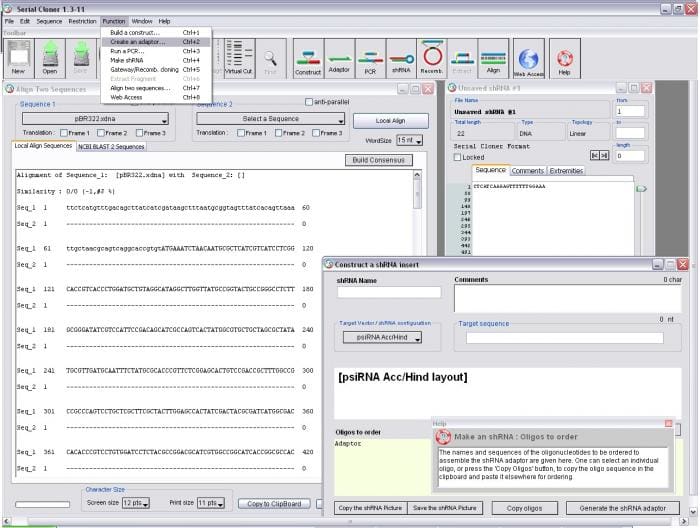


- #Serial cloner feature import how to
- #Serial cloner feature import full version
- #Serial cloner feature import serial
- #Serial cloner feature import software
- #Serial cloner feature import license
Photoshop was developed in 1987 by two brothers Thomas and John Knoll, who sold the distribution license to Adobe Systems Incorporated in 1988. Collectively, they are branded as "The Adobe Photoshop Family".
#Serial cloner feature import full version
As of November 2019, Adobe has also released a full version of Photoshop for the iPad, and while initially limited, Adobe plans to bring more features to Photoshop for iPad.
#Serial cloner feature import software
Historically, Photoshop was bundled with additional software such as Adobe ImageReady, Adobe Fireworks, Adobe Bridge, Adobe Device Central and Adobe Camera RAW.Īlongside Photoshop, Adobe also develops and publishes Photoshop Elements, Photoshop Lightroom, Photoshop Express, Photoshop Fix, Adobe Illustrator, and Photoshop Mix. With the introduction of the Creative Cloud branding in June 2013 (and in turn, the change of the " CS" suffix to " CC"), Photoshop's licensing scheme was changed to that of software as a service subscription model. Photoshop CS3 through CS6 were also distributed in two different editions: Standard and Extended. However, in October 2002 (following the introduction of Creative Suite branding), each new version of Photoshop was designated with " CS" plus a number e.g., the eighth major version of Photoshop was Photoshop CS and the ninth was Photoshop CS2. Photoshop's naming scheme was initially based on version numbers. Its feature set can be expanded by plug-ins programs developed and distributed independently of Photoshop that run inside it and offer new or enhanced features. In addition to raster graphics, Photoshop has limited abilities to edit or render text and vector graphics (especially through clipping path for the latter), as well as 3D graphics and video. Photoshop uses its own PSD and PSB file formats to support these features. Photoshop can edit and compose raster images in multiple layers and supports masks, alpha compositing and several color models. "to photoshop an image", " photoshopping", and " photoshop contest") although Adobe discourages such use. The software's name is often colloquially used as a verb (e.g. Since then, the software has become the most used tool for professional digital art, especially in raster graphics editing. It was originally created in 1987 by Thomas and John Knoll. Getting Started with MacVector: An overview of primer design workflows in MacVector.American English, British English, Arabic, Mandarin Chinese, Chinese Traditional, Czech, Danish, Dutch, Finnish, French, German, Hebrew, Hungarian, Italian, Japanese, Korean, Norwegian, Polish, Portuguese, Russian, Spanish, Swedish, Romanian, Turkish and UkrainianĪdobe Photoshop is a raster graphics editor developed and published by Adobe Inc.Melissa Caimano on HOW DO I video guides to common molecular biology workflows.admin on HOW DO I video guides to common molecular biology workflows.mariam abdelmalak on Major release details – Summary.Brian on Designing primers and documenting In-Fusion Cloning with MacVector.Chris on Designing primers and documenting In-Fusion Cloning with MacVector.
#Serial cloner feature import how to
#Serial cloner feature import serial
MacVector will directly import many file formats such as common sequence formats such as Genbank, FASTA, FASTQ plus from software packages such as Sequencher Projects and Serial Cloner, For example you may prefer features to be displayed on just those two levels instead of being distributed over the multiple levels as per the default settings. However, MacVector’s graphics are highly customizable and you can adjust the graphical settings to display the plasmid exactly as you want. This sequence was opened using the MacVector defaults. It’s been opened directly in MacVector by double clicking the file. Here’s a plasmid sequence downloaded from the Addgene website in Snapgene format. However, Snapgene will always place features on the same two levels and so features sometimes overlap. For example MacVector has multiple levels (up to six) outside and inside a plasmid and will always try to place features so that no feature overlaps another. However, there are some aspects to the display that are not the same between the two applications. The colors of features will be the same as the original. When you import a Snapgene file the appearance will be very similar. This is very useful when downloading plasmid sequences from the wonderful Addgene plasmid repository. You just need to use FILE | OPEN or double click the file. MacVector will directly import SnapGene DNA files.


 0 kommentar(er)
0 kommentar(er)
